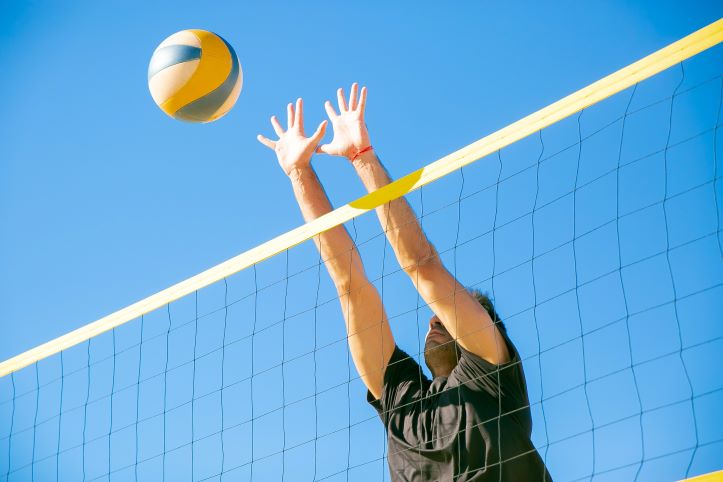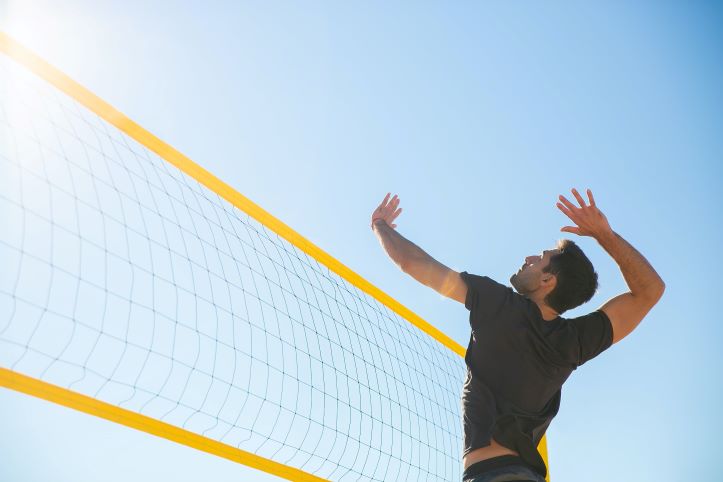Wondering how to jump higher in volleyball? Not just you. Every volleyball player wonders about it. In volleyball, “soaring to new heights” is more than just a figure of phrase; it’s a big deal. You’re about to learn how to resist gravity, make those jaw-dropping spikes, and become a force on the court that can’t be stopped.
It’s not just about putting on amazing shows for your friends. It’s about becoming a team player that can’t be missed. We know all the tricks, tips, and exercises that will help your vertical jump go through the roof. No matter how experienced you are, this site has something for you.
Get ready to step up your game. Let’s learn more about the interesting world of volleyball jumping higher. We’ll show you the most important moves and methods that will amaze your opponents.

Top 6 Steps On How To Jump Higher In Volleyball
Step #1: Build Strong Legs
Legs are the powerhouse behind those explosive leaps. Building leg strength is your golden ticket to success.
Your legs are like coiled springs. The stronger they are, the more potential energy you can unleash when you jump. Because stronger legs generate more power against the ground, you can fly higher. For volleyball success, leg strength is essential.
Exercises to build leg strength
- Squats: Squats are the king of leg exercises. They work your quadriceps, hamstrings, and glutes. To do them, stand with your feet shoulder-width apart and lower your body as if you’re sitting in an imaginary chair. Keep your back straight and your knees behind your toes.
- Lunges: Lunges target each leg individually, promoting balance and strength. Step forward with one foot and lower your body until both knees are bent at a 90-degree angle. Then, return to the starting position and switch legs.
- Calf raises: Your calves are vital for that final push when you jump. To strengthen them, stand with your feet hip-width apart and raise your heels as high as you can. Lower them back down and repeat.
Consistency is key in building leg strength. Include these exercises in your workouts to progressively increase leg power and vertical jump. Remember, Rome wasn’t built in a day, and neither is a higher jump.
Step #2:Perfect Your Jump Technique
It’s not all about brute strength – technique plays a pivotal role. Improve your vertical jump with proper technique.
Think of technique as the finesse of your jump. It’s the difference between a rocket-propelled launch and an uncontrolled hop. The right technique might help you harness leg strength for a higher, more controlled jump.
A successful volleyball jump comprises three main components:
- Approach: This is your runway to the jump. A well-executed approach involves a quick, controlled run-up, ensuring you hit the ball at the perfect moment.
- Takeoff: The takeoff is where the magic happens. It’s the point at which you spring into the air. Proper timing and form are essential to maximize your jump height.
- Swing: Your swing is like the finishing touch. It’s how you direct the ball, and it can either make or break your play. A strong, precise swing is critical for success.
Tips For Refining Your Technique
- Focus on your timing. Practice your approach and takeoff to ensure they’re smooth and well-timed.
- Pay attention to your arm swing. A powerful, controlled swing can give you the edge.
- Video analysis is a great option. Record your jumps and assess your technique for areas of improvement.
- Seek guidance from experienced coaches or players. They can give you personalized feedback and tips.
Step #3: Improve Flexibility and Agility
Flexibility is like the secret sauce of vertical jumps. When your muscles and tendons are more flexible, they can lengthen and contract more efficiently. This results in a greater range of motion Which allows you to generate more power during your jump.
Stretches to improve flexibility
- Hamstring stretches: Tight hamstrings can limit your ability to extend fully during a jump. To stretch them, sit with your legs extended and reach for your toes. Hold the stretch for 15-30 seconds.
- Hip flexor stretches: Flexible hip flexors are crucial for a strong takeoff. Kneel on one knee, keeping your back straight, and push your hips forward. Hold for 15-30 seconds on each side.
Agility drills for better performance
- Ladder drills: Lay out an agility ladder and practice quick, precise footwork. This will improve your speed and agility on the court, helping you get to the ball faster.
- Cone drills: Set up a series of cones and practice zig-zagging through them. This enhances your lateral movement and overall agility.
- Dot drills: Use tape or markers to create a pattern on the floor. Jump between the dots as fast as you can, improving your explosive power.
Step #4: Proper Nutrition and Hydration
It’s not just about what you do on the court. It’s also about what you put into your body. Think of your body as a high-performance car. To get the best out of it, you need the right fuel. What you eat has a direct impact on your energy levels, muscle strength, and endurance. A balanced diet can make the difference between a sluggish jump and a powerful spike.
Foods That Promote Muscle Strength And Endurance
- Lean Protein: Protein is the building block of muscles. Incorporate lean sources like chicken, turkey, and fish into your diet to support muscle growth and repair.
- Complex Carbohydrates: Carbs are your body’s primary source of energy. Opt for whole grains, brown rice, and oats to fuel your workouts.
- Healthy Fats: Don’t shy away from fats – the good kind, that is. Avocado, nuts, and olive oil provide sustained energy and aid in recovery.
- Vitamins and Minerals: Fruits and vegetables are packed with essential nutrients. They enhance your overall health and help maintain peak performance.
The role of hydration for the fitness of a player is very significant. Dehydration can quickly drain your energy and compromise your jump. When you’re on the court, you’re losing fluids through sweat. It’s crucial to replenish them to maintain your strength and stamina. Water is your best friend here. Make sure to drink enough before, during, and after your game.
Step #5: Build a Strong Mindset
The power of the mind is often underestimated. In volleyball, a strong mental game can boost your performance. When you enter the court with confidence and focus, you can defy gravity and jump high.
Techniques for mental preparation:
Visualization
Close your eyes and vividly imagine a flawless jump. Picture yourself soaring above the net, making that perfect spike. Visualization not only boosts your confidence but also helps program your mind for success.
Positive self-talk
The words you say to yourself matter. Replace doubts and negativity with affirmations of your capabilities. Remind yourself that you’re a skilled athlete capable of incredible feats.
Overcoming mental barriers
We all face mental hurdles from time to time. Whether it’s fear of failure or anxiety, recognizing these barriers is the first step to overcoming them. Practice mindfulness techniques to stay present and focused during the game.
Preparing your mind is just as important as training your body. Physical and mental preparation are equally important. Strengthening your mental resilience can help you overcome gaming challenges and push yourself to jump higher.
Step #6: Take Proper Rest for Recovery
Rest isn’t a sign of weakness. It’s a crucial part of the strength-building process. When you engage in intense training and jumps, your muscles experience microscopic tears. It’s during rest that your body repairs and rebuilds these muscles. This makes them even stronger than before.
Tips for effective recovery:
Sleep
The most critical aspect of recovery is sleep. Your body regenerates and repairs itself during deep sleep cycles. Aim for 7-9 hours of quality sleep each night to ensure your muscles are ready to perform at their best.
Rest days
Use the power of rest days. Schedule days in your training regimen where you allow your body to recover fully. It’s during these breaks that your muscles replenish glycogen stores and heal.
Avoid overtraining
Pushing your body to its limits is essential, but overtraining can be detrimental. Listen to your body. If you experience excessive fatigue, persistent soreness, or a drop in performance, it might be time for a rest day.
Exercises To Jump Higher And Increase Vertical
Here we are sharing some core exercises to help you jump higher in volleyball:
1. Vertical Jumps
- Stand with your feet shoulder-width apart.
- Bend your knees and swing your arms back.
- Explode upward as high as you can, extending your arms above your head.
- Land softly with slightly bent knees.
- Repeat for multiple sets and reps.
2. Medicine Ball Throws
- Hold a medicine ball with both hands.
- Squat down, then explode up and throw the ball against a wall or to a partner.
- Catch the ball and repeat.
- This exercise builds explosive power in your legs and core.
3. Box Jumps
- Find a sturdy box or platform.
- Start with your feet hip-width apart.
- Bend your knees and jump onto the box, landing softly.
- Step back down and repeat.
- This exercise builds leg strength and power.
4. Depth Jumps
- Find an elevated surface, like a box or bench.
- Stand on it, step off, and as soon as you touch the ground, explode into a vertical jump.
- This exercise trains your muscles for rapid force production, essential for quick, powerful spikes.
5. Tuck Jumps
- Begin in a standing position.
- Jump as high as you can while bringing your knees up towards your chest.
- This exercise replicates the dynamic nature of a volleyball jump and improves vertical explosiveness.
6. Planks
- Start in a push-up position but with your weight supported on your forearms.
- Keep your body in a straight line from head to heels.
- Hold the position for as long as you can.
- Planks build a strong core for better stability during jumps.
7. Russian Twists
- Sit on the ground with your knees bent and feet flat.
- Lean back slightly, lift your feet off the ground, and hold a weight or a volleyball with both hands.
- Twist your torso to one side, touching the object to the ground beside you, then repeat on the other side.
- This exercise enhances rotational power, vital for explosive volleyball moves.
8. Hurdle Hops
- Set up a series of low hurdles or obstacles.
- Stand facing the hurdles.
- Jump over each hurdle one by one.
- Focus on quick, explosive jumps.
- This exercise enhances your vertical leap and agility.
Conclusion
Now, it’s your turn. Take these tips and techniques, and put them into practice. Commit to your training, fuel your body right, and cultivate the unshakable mindset of a volleyball champion.
Remember, every leap, every spike, and every victory starts with that one jump. So step onto the court with confidence, fly above the net, and become a professional volleyball player. Your potential knows no bounds. It’s time to seize it and touch the sky!








